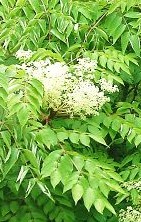 This deciduous small tree or shrub is native to eastern Russia, Japan, China and Korea but is grown in the US where it has become invasive in some areas due to its large suckering root system. The spiny stems carry, binnately compound leaves 3-5.5 feet long that are dark to mid-green in summer and turn yellow to reddish purple in the fall. The small (1/8”) white to pink flowers are produced in August in billowy terminal panicles twelve to eighteen inches across. They are attractive to bees and are followed by black spherical fruits. Plants are drought and pollution tolerant but needs protection from wind that can damage their leaves. Flowers, leaves, and preserved berries are attractive in arrangements. A variegated form, A. elata ‘Aureovariegated, has larger and more eye-catching leaves and is best used with restraint.
This deciduous small tree or shrub is native to eastern Russia, Japan, China and Korea but is grown in the US where it has become invasive in some areas due to its large suckering root system. The spiny stems carry, binnately compound leaves 3-5.5 feet long that are dark to mid-green in summer and turn yellow to reddish purple in the fall. The small (1/8”) white to pink flowers are produced in August in billowy terminal panicles twelve to eighteen inches across. They are attractive to bees and are followed by black spherical fruits. Plants are drought and pollution tolerant but needs protection from wind that can damage their leaves. Flowers, leaves, and preserved berries are attractive in arrangements. A variegated form, A. elata ‘Aureovariegated, has larger and more eye-catching leaves and is best used with restraint.
Cutting: No special treatment
Conditioning: Dip cut stems ends in boiling water and then give them a long drink.
Preserving: Seed heads in the berry stage can be preserved with a solution of glycerin and water.
Cultivation:
Size
- : 20-30’ H x 15-30’ W
Light:
- Part shade to full sun
Soil:
- Average to lean, moderately moist, well-drained, acidic
Hardiness:
- Zones 3-8
Propagation:
- Division in late winter, root cuttings in winter, seed sown immediately when ripe
Care:
- Remove suckers to contain growth